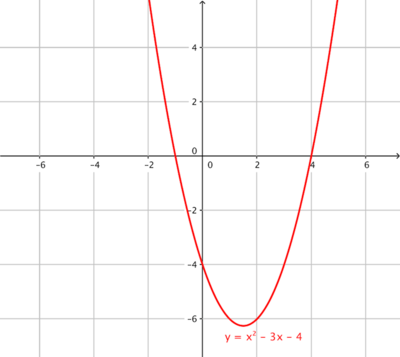A-level Mathematics/Edexcel/Core 1/Algebra
< A-level Mathematics < Edexcel < Core 1Mathematics revolves around Algebra, so sufficient knowledge of this is essential. You should recognise most of this from your GCSE course, but it's important to ensure you understand this.
Pure Maths 1, Module 1, Algebra
Collecting like terms
Several terms in the same unknown can be contracted, or collected together, making them much easier to work with, for example,  , similarly, the same works with subtraction,
, similarly, the same works with subtraction,  is the same as
is the same as  .
.
Laws of indices
1.  .
.
For example,. This is the same as
. Or
2.  .
.
For example,, expands to
. Three of the
's on the top line cancel out, leaving us with
3. 
For example,or
4.  where
where 
For example,
5. ![x^{\frac{a}{b}} = \sqrt[b]{x^a} = (\sqrt[b]{x})^a](../I/m/30c467984cce0ec14e0af25bc582d58d.png)
For example,
Manipulation of surds
A surd is an irrational number, meaning it cannot be written exactly in decimal or fractional form, an example is  , numbers are written in surd form because writing it any other way would reduce the accuracy, and in mathematics an exact value is needed. There are two rules of surd manipulation required for C1:
, numbers are written in surd form because writing it any other way would reduce the accuracy, and in mathematics an exact value is needed. There are two rules of surd manipulation required for C1:
1. 
For example,.
2. 
For example,
Sometimes a surd may need to be expressed as  , this is done by finding a square number, like 4 or 9, that multiplies into the surd, which then can be taken outside the square root and put in front:
, this is done by finding a square number, like 4 or 9, that multiplies into the surd, which then can be taken outside the square root and put in front:
For example,
Quadratic functions
Graphs
The general form of a quadratic equation is  , where a, b, and c are constants.
, where a, b, and c are constants.
A graph can be sketched by simply taking values of  and calculating the values of
and calculating the values of  using the equation of the graph given. These values can then be plotted onto the graph:
using the equation of the graph given. These values can then be plotted onto the graph:
For example,  , then taking x between -2 and +5 gives:
, then taking x between -2 and +5 gives:
| x | -2 | -1 | 0 | 1 | 2 | 3 | 4 | 5 |
| y = x2-3x-4 | 6 | 0 | -4 | -6 | -6 | -4 | 0 | 6 |

Equations and Inequalities
Simultaneous Equations
Simultaneous equations are two or more equations where you have to find values for unknowns that satisfy both. There are two methods you need to know about for solving them.
Elimination
Elimination involves 'taking away' or 'adding' the two equations together to eliminate on of the two unknowns. Here's an example:

In this case, adding the equations together will eliminate y:

We can then solve  to get
to get  . This value of x can then be put back into one of the original equations to find the value of y:
. This value of x can then be put back into one of the original equations to find the value of y:

Sometimes, you may have to change one of the equations to be able to use elimination. Look at the following two:

Neither of the unknowns can be eliminated at the moment but by multiplying the whole of the first equation by 2 it makes it possible to eliminate by taking one away from the other:

This can then be substituted back into one of the original equations to find y:

Inequalities
Linear
Inequalities can be manipulated in the same way an equation can be with an extra rule: when multiplying or dividing by a negative value, the greater/less than must be switched to the other.
For example:
Quadratic
Critical values
For the inequality  , consider the corresponding equation
, consider the corresponding equation  . Solve the equation for x; the two values of x you obtain are known as the critical values, and represent the limits between which the solutions for the inequality lie. For example:
. Solve the equation for x; the two values of x you obtain are known as the critical values, and represent the limits between which the solutions for the inequality lie. For example:


 or
or  .
.
Therefore critical values are -1 and 3.
In the above example, the solution is either  or
or  . To determine which one it is, plug in any value, apart from the critical values, into the original inequality and see if the inequality is true, if it is the value you plugged in is in the solution set.
. To determine which one it is, plug in any value, apart from the critical values, into the original inequality and see if the inequality is true, if it is the value you plugged in is in the solution set.
Continuing from the above example, let  .
.
This shows that 0 is a solution, and as it lies in  ,
,  is the solution
is the solution




![8^{\frac{2}{3}} = {\sqrt[3]{8}}^2 = 2^2 = 4.](../I/m/57f4387e60e9c54d654b73bff569e5d6.png)



